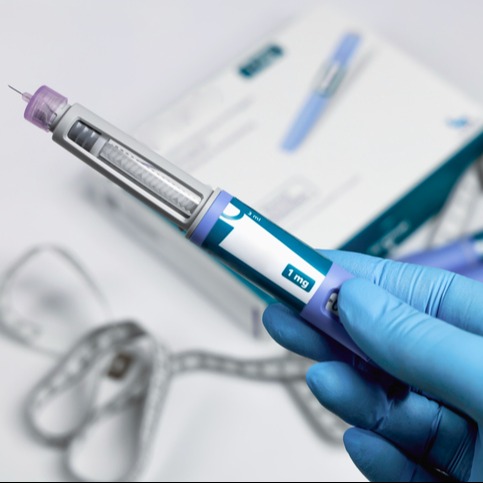
Check your pen and attach a new needle. Make sure your pen contains clear and colorless Ozempic®. Screw on a new needle and pull off both needle caps. Check the flow with each new pen, turn the dose selector to select the flow check symbol. Press and hold in the dose button. Repeat until a drop appears. Select your dose and turn the dose selector until the dose counter shows your dose (0.25 mg, 0.5 mg or 1.0 mg). Inject your dose and insert the needle. Press and hold down the dose button. After the dose counter reaches 0, hold for at least 6 seconds to make sure you receive the full dose. And then lastly, remove the needle and replace the outer needle. Carefully remove and dispose of the needle. Put the pen cap back on.
For a full list of instructions and a more detailed outline of how to take ozempic, follow the guide below.
Key Takeaways
Make sure to prepare your injection site ahead of time. Choose either your abdomen, thigh, or arm for the injection site. Avoid injecting Ozempic into any muscle (intramuscularly) or vein (intravenously). Use the various muscles as regions to try and pinpoint.
Ozempic is always injected under the skin (subcutaneously) on your stomach (abdomen), thigh, or upper arm. Do not use the same site for each injection. If you use the same region twice, try to avoid the exact injection site as it could turn red, tender, and sore.
Always follow the instructions provided on your ozempic leaflet that’s provided with each pen. Check to ensure that the color of the liquid is clear and doesn’t have any signs of chunks or particles as part of the liquid (which would deem it potentially bad and unusable).
How to Take Ozempic
Follow these steps to properly take your Ozempic (semaglutide) injection:
1. Prepare Your Injection Site
Your injection site includes any fatty portion of your body on your arm (near your bicep), your thigh (near your quadricep) and your abdomen (usually around 2” from your belly button). You may want to swab the injection site with a small alcohol swab or clean it with soap and water to prepare the injection site.
2. Remove the Pen Cover and Clean the Pen
Remove the pen cover, take an alcohol swab, and gently clean the top of the pen. You’ll want to do this before adding the pen needle to the pen itself.
3. Add the Pen Needle
Take the pen needle and remove the paper tab on the bottom. Place the pen needle on top of the pen and turn it clockwise until the pen feels secure. If you overtighten the pen you may need to loosen it and then tighten it again.
There are two caps on your pen needle. First, remove the clear outer cap and place it aside. Second, remove the inner cap and discard that cap. You will no longer need that second cap.
4. Prime the Pen
The needle is only prime the first time that you use the pen. Turn the dose dial to the first dial on the pen. Hold the pen with the needle pointing upwards and press the plunger. You should see a small water droplet begin to show.
5. Turn the Dose Dial
Once you’ve primed the pen, turn to the dose dial to the proper dosage that you’ve been given by your physician or primary care doctor.
6. Prime Your Injection Site
Holding the pen to a 90-degree angle to the injection site. Push the pen all the way into the skin. Once all the way, begin to press down on the plunger. Hold and count to 6-seconds to ensure that all of the medication is injected into the injection site.
7. Return the Pen Cap
Take the clear outer cap once you’ve finished injecting. And place the cap on top of the needle. When it is firmly in place, rotate the cap counterclockwise until the needle is loose. Place the used needle into a sharps container. And then place the cap back onto the pen.
Once your sharps container is full you’ll want to find a safe place to dispose of your needles using this geographic search tool. Do not dispose of your needles in the regular trash recital that you would otherwise use on a weekly basis.
Tips to Help with Ozempic Side Effects
Here are some tips to manage the side effects.
1. Change Your Eating Patterns
Ozempic have common side effects such as nausea, headache, dizziness, and constipation. This usually affects 1 in every 10 patients. To reduce this, change up your eating patterns and ensure that you are only eating up to about “80%” of feeling “full.”
Smaller more frequent meals throughout the day can also help to reduce symptoms.
2. Change Up the Injection Times
If you are feeling nausea as a common side effect. And usually occurs the day after injection. Try to take the injection on Friday evenings, away from work hours so that you can better prepare for the side effects that could take place.
3. Use the Thigh for Avoiding The Gastrointestinal Side Effects
Injecting Ozemic into the thigh can cause the semaglutide to absorb more slowly. This can help to reduce the severity of some of the side effects. Specifically, it can help with some of the gastrointestinal side effects (or gas) that may come with the injection.
It may not entirely curb the nausea or dizziness side effects that occur the day after injection. However, it may be up to the user to determine what works best for them.
Securely Shop for Prescriptions From Canada and other International Pharmacies at Drugmart.com
When you shop at Drugmart.com, you benefit from lower prescription drug prices without sacrificing safety. We pass on the savings from our trusted international partners' competitive pricing so that you can realize the value of pharmaceutical importation. Sign up and start safely importing prescription drugs for personal use today!
Sources
OZEMPIC (semaglutide) injection, for subcutaneous use. Accessed April 21, 2024 at https://www.accessdata.fda.gov/drugsatfda_docs/label/2020/021897s049lbl.pdf
Canadian Agency for Drugs and Technologies in Health (CADTH). (2019). Clinical Review Report: Semaglutide (Ozempic): (Novo Nordisk Canada Inc.). Canadian Agency for Drugs and Technologies in Health. Retrieved from https://pubmed.ncbi.nlm.nih.gov/31305971/
Chamberlin, S. & Dabbs, W. (2019). Semaglutide (Ozempic) for type 2 diabetes mellitus. American Family Physician, 100(2), 116–117. Retrieved from https://pubmed.ncbi.nlm.nih.gov/31305048/
DailyMed. (2022). OZEMPIC-semaglutide injection, solution. National Library of Medicine. Retrieved from https://dailymed.nlm.nih.gov/dailymed/drugInfo.cfm?setid=adec4fd2-6858-4c99-91d4-531f5f2a2d79
Food and Drug Administration (FDA). (2020). Drug trial snapshot: Ozempic. Food and Drug Administration. Retrieved from https://www.fda.gov/drugs/drug-approvals-and-databases/drug-trial-snapshot-ozempic
Medline Plus. (2021). Semaglutide injection. American Society of Health-System Pharmacists, Inc. Retrieved from https://medlineplus.gov/druginfo/meds/a618008.html
O'Neil, P. M., Birkenfeld, A. L., McGowan, B., et al. (2018). Efficacy and safety of semaglutide compared with liraglutide and placebo for weight loss in patients with obesity: a randomised, double-blind, placebo and active controlled, dose-ranging, phase 2 trial. Lancet (London, England), 392(10148), 637–649. doi:10.1016/S0140-6736(18)31773-2. Retrieved from https://pubmed.ncbi.nlm.nih.gov/30122305/
Wilding, J., Batterham, R. L., Calanna, S., et al. (2021). Once-weekly semaglutide in adults with overweight or obesity. The New England Journal of Medicine, 384(11), 989–1002. doi:10.1056/NEJMoa2032183. Retrieved from https://pubmed.ncbi.nlm.nih.gov/33567185/





